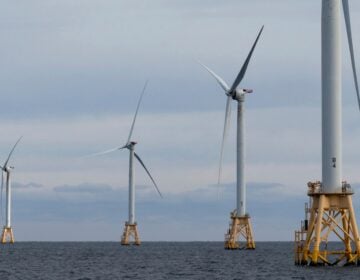This company wants to recycle your plastic bags. There’s a lot riding on whether it succeeds
J.P. Mascaro & Sons has started a test project that puts flexible plastic packaging into its single stream, which also includes paper, glass, and other recyclables.
Listen 4:31On any given day, J.P. Mascaro & Sons’ recycling plant outside Reading, Pa., receives anywhere from 500 to 600 tons of recyclable material.
There are heaps of cardboard boxes, mountains of glass jars and aluminum cans, and towers of plastic water and soda bottles, all of which J.P. Mascaro’s Total Recycle plant has processed for years.
But there’s also a lot of material it technically cannot process: frying pans, car transmissions, and a swath of plastic bags and other material made of thin, flexible plastic — shrink wrap, Snickers wrappers, potato chip bags, the plastic lining of your cereal box, the bags that pre-washed spinach and salad greens are sold in, Go-Gurt pouches.
That last category, known as flexible plastic packaging, is one the recycling industry has been grappling with in recent years.
“We estimate it to be about 1% of our intake now, and that number will only go up,” said T.J. Stinson, J.P. Mascaro’s recycling coordinator.
Do the math: 1% of 500 tons means at least five tons of plastic packaging that until recently the company wasn’t set up to handle.
The fact that the plant sees so much stems from the material’s ubiquity. Flexible plastics are the most popular form of packaging in the United States. Americans use 12 billion pounds of the stuff each year, and it’s the fastest growing segment of packaging.
It’s also notoriously difficult to recycle. Existing recycling equipment isn’t set up to sort it — the thin, lightweight plastic bags and packages get tangled in sorting machinery and gum up the works, often requiring plants to shut down while workers manually remove the bags. It also contaminates the paper-recycling stream because most equipment can’t differentiate between lightweight plastic and lightweight paper.
That has made it something of a bete noire for the industry. Store drop-off programs exist for the material, but analysts estimate that accounts for about 1.7% of all the flexible packaging in circulation. In recent recycling-awareness campaigns, haulers and municipalities have emphasized that plastic bags and their brethren do not belong in residents’ recycling bins.
J.P. Mascaro is trying to change that. Instead of sending the material to the landfill, the current practice, the company has launched a pilot project to recycle flexible plastic.
“What we are trying to do is get all of the packaging material that currently goes in the landfill, get it into our building, accumulate it, and find a new market that we can put it back to use, give it a second life,” Stinson said.
The project is largely funded by a group called Materials Recovery for the Future, which itself is funded by companies responsible for producing the plastics, including Procter & Gamble, PepsiCo, and Target. Those companies have no doubt felt pressure in recent years as anti-plastics sentiment has grown, leading to legislation like the recent plastic bag ban in New York and proposed bans on single-use plastics in Pennsylvania.
But Susan Graff, vice president of global corporate sustainability at Resource Recycling Systems, an environmental research firm that launched Materials Recovery for the Future, said those corporations want to be part of the solution.
“There’s good reason for skepticism,” Graff said. “But the brands have been very clear. They’re listening to consumers.”
Some 94% of consumers think recycling is a good idea and say they will recycle if it’s convenient for them, she said.
“The trick is to do it most economically and technically feasible and with the lowest carbon footprint.”
That’s a challenge when it comes to flexible plastic. So far, the options for next-generation products made from recycled flexible plastic — or rFlex, as Graff called it — include corrugated pipes, decking materials like Trex or Timbertech, playground surfaces, and other building materials. But given that recycled products have the potential to contain impurities, like nanoparticles of food or dust, they can’t be used for anything where purity is essential, such as medical products or food packaging.
Stinson and Graff both pointed to biodiesel as another product that could be made from rFlex. But Grace Hsuan, professor of civil, architectural and environmental engineering at Drexel University, said that might be very expensive and not particularly green.
“It’s a good idea,” Hsuan said. “But sometimes, a good idea may turn out not to be so ideal at the end because the process is so complicated and so energy-demanding.”
That hasn’t dissuaded Stinson or Graff.
“[Flexible plastic] is everywhere,” said Graff. “Let’s not set up to landfill it.”
Part of the reason flexible plastic has been such a headache for the industry in recent years is that most U.S. plants are recycling a 2019 stream using equipment that’s more than a decade old.
“The material changed,” Graff said. “In order to adapt, it’s going to require new infrastructure.”
That won’t come cheap. Upgrading a large facility like J.P. Mascaro’s to handle flexible plastic would cost $3 million to $5 million. An older plant might cost even more because older equipment is harder to retrofit.
Materials Recovery for the Future has paid for most of J.P. Mascaro’s upgrades. The rest of the 600-some recycling facilities across the United States might not have that luxury, and, for smaller plants, such upgrades might not make economic sense.
Still, for a company like J.P. Mascaro, there are benefits. This material already is coming to the plant mistakenly, causing headaches. Using new equipment to sort, collect, and pack the flexible plastic will provide a means of reducing contamination of its other recycling streams — notably paper — and, it’s hoped, will lead to a market for the stuff.
“We hope that allowing this in your single stream puts the burden on us to sort the material and makes it easier for you guys to keep putting things in one container,” Stinson said.
Right now, any flexible plastic material the company packs into a bale has gotten to the plant by mistake; it isn’t ready for people to start putting flexible plastic into their recycling bins yet. J.P. Mascaro just wants to test its new equipment, to make sure it works and is shopping around test bales to see who might be able to turn the material into something useful.
If all goes as planned, the company plans to test the program this summer in two nearby communities: Birdsboro and Pottstown. Eventually, it wants to collect from the other 100 municipalities it serves in the Philadelphia region.
“We assume that there’s going to be some hiccups, some snags,” Stinson said. “We might have to change this a little bit as we find out what works and doesn’t work.”
But there is more riding on this program than the success of a local company. In the face of growing problems for and skepticism of the recycling industry, the ability to economically and cleanly recycle flexible plastic material would be a big win — for the planet, too.
Inability to do so would be another strike against an industry facing headwinds from unfavorable market forces, and would likely intensify public pushback against this type of packaging.
“If it works, it solves our problems, and it helps [J.P. Mascaro] make a living,” said Thomas Kinnaman, a professor of economics at Bucknell University who researches worldwide trends in recycling and incineration. “So within that context, it’s a win-win for everybody.
“But if it leads to false hope and false promise and bad policy decisions by municipal leaders,” Kinnaman said, “then that’s a problem.”
WHYY is your source for fact-based, in-depth journalism and information. As a nonprofit organization, we rely on financial support from readers like you. Please give today.





